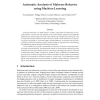Free Online Productivity Tools
i2Speak
i2Symbol
i2OCR
iTex2Img
iWeb2Print
iWeb2Shot
i2Type
iPdf2Split
iPdf2Merge
i2Bopomofo
i2Arabic
i2Style
i2Image
i2PDF
iLatex2Rtf
Sci2ools
JCS
2011
2011
Automatic analysis of malware behavior using machine learning
Malicious software—so called malware—poses a major threat to the security of computer systems. The amount and diversity of its variants render classic security defenses ineffective, such that millions of hosts in the Internet are infected with malware in form of computer viruses, Internet worms and Trojan horses. While obfuscation and polymorphism employed by malware largely impede detection at file level, the dynamic analysis of malware binaries during run-time provides an instrument for characterizing and defending against the threat of malicious software. In this article, we propose a framework for automatic analysis of malware behavior using machine learning. The framework allows for automatically identifying novel classes of malware with similar behavior (clustering) and assigning unknown malware to these discovered classes (classification). Based on both, clustering and classification, we propose an incremental approach for behavior-based analysis, capable to process the ...
| Added | 15 Sep 2011 |
| Updated | 15 Sep 2011 |
| Type | Journal |
| Year | 2011 |
| Where | JCS |
| Authors | Konrad Rieck, Philipp Trinius, Carsten Willems, Thorsten Holz |
Comments (0)

